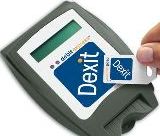To create a service that lets consumers quickly purchase goods, start-up Dexit has turned to RFID to underpin its cashless payments system. “We looked at payment technologies, including mag stripe, dynamic barcode, contact cards and others, but only RFID was easy for consumers to use and had a price point that was low enough to be manageable for both consumers and merchants,” says Pierre Roberge, Dexit’s vice president of technology.
In September Dexit launched its electronic payment service in its home city of Toronto and says it is on the way to reaching twin targets of 50,000 contactless cards and 300 readers in operation in the city by April next year. So far, 150 readers have been installed, with some stores deploying as many as 12 readers.
“We are focusing on our Toronto launch till April 2004,” says Roberge. “Plans are being put in place for our expansion for the remainder of next year.”
Dexit’s goal is to provide a service that complements existing cashless payment methods such as debit and credit by replacing cash payments in transactions too small for those other payment types. “Our main rival is cash. Debit and credit cards penetration in our target market is less than 10 percent of small transactions,” says Roberge. Dexit charges the merchant a fee for each transaction, but the rate is competitive with those for credit and debit cards, according to the company.
After a purchase has been rung up at cash register, a customer can pay using a Dexit tag, a thin 1- by 2-inch plastic tag that attaches to a key ring or cell phone. The customer need only wave the RFID-enabled tag in front of the RFID reader at the register. The company says its system can receive a transaction request and authorise a payment within two seconds—a fraction of the average 30 seconds it takes to carry out a transaction by other methods. “That may not sound like much, but for a coffee shop or newspaper seller that does most of its business between 7 a.m. and 9 a.m., it can make a real difference,” says Roberge.
To obtain a Dexit account, consumers simply sign up for the service. They can then load funds from their Canadian bank account or through preauthorized debit or electronic bill payment. Using electronic bill payment, consumers can replenish their account on the Internet, by telephone or at a bank ATM. The RFID transponder within Dexit tag holds a unique number as well as other data linked to a single customer but contains no personal information, says Roberge. Adding value to the tag costs $1.50 per transaction. Consumers can spend up to $100 per day with Dexit’s tag.
The company says its system uses tags and readers from Inside Contactless, an RFID equipment maker based in Aix en Provence, France.
“Dexit was built around the 14443 protocol, which means a passive tag with a read-range capability up to 10 cm,” says Roberge. He explains that his company’s decision to go with Inside was a practical one. For example, some RFID gear commonly used for contactless payments, such the Texas Instrument system used for the ExxonMobil Speedpass, couldn’t meet Dexit’s technological requirements.
“Speedpass is based on an older and proprietary RFID technology,” says Roberge. “We wanted to roll out our offering on something more flexible, more secure and supported by many vendors. We felt that ISO 14443 is future proof, as far as payment application is concerned. The industry validated our research since then.”
Roberge found, however, that Inside was the only vendor that could also meet Dexit’s production deadlines.
“Inside was a rarity because its technology was already in the marketplace. Other companies said they had what we needed, but we would find the products were still in their labs,” says Roberge.
In the U.S. several RFID-based payment services already exist. ExxonMobil’s popular Speedpass lets customers pull up to the pump, wave a Speedpass key fob past an RFID reader built into the pump and start filling up. Philips 66 and Citgo have followed suit, but analysts have criticised all these deployments for being proprietary systems that require separate tags for each gasoline supplier (see Problems at the Pump. In trial of a system similar to Dexit’s, American Express has been testing its ExpressPay RFID payment product with merchants in the Phoenix area, but the trial’s users consist mostly of AmEx employees (see AmEx Expands RFID Payment Trial.


